Yellow Leaves at the Bottom of Your Tomato Plants?
Have you noticed yellow leaves on your tomato plants? Any time our vibrant, healthy plants begin to show stress, we naturally worry. What is the cause, and what can we do?
Yellowing tomato leaves can be caused by a variety of factors. The most common cause, characterized also by brown spots, is early blight. Thankfully, when caught early, it can be controlled.
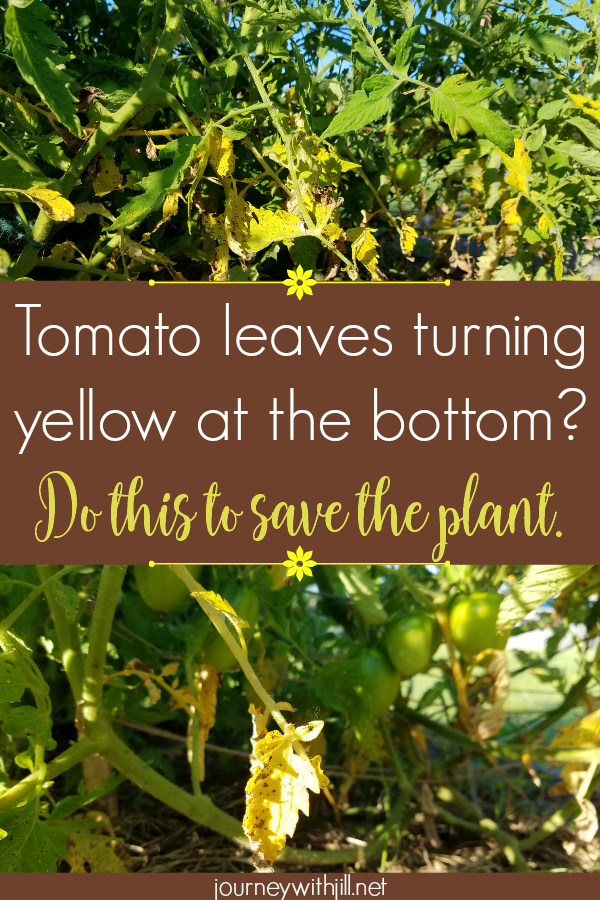
Early Blight Causes Yellow Tomato Leaves
When the bottom leaves of a tomato plant turn yellow with brown spots, early blight is usually the culprit. Early blight is caused by a fungus, either Alternaria tomatophila or Alternaria solani.
The official names aren’t important. What IS critical to understand is how it affects your plants.
Early blight occurs and spreads in wet and humid conditions. Since the fungus originates from the soil-level, early blight begins on leaves toward the bottom of the plant. When rain splashes on the ground, the fungal spores attach to the low-lying leaves.
I have found early blight to be particularly problematic when we experience a spring or early summer with higher rainfall amounts.
How Do You Stop Early Blight without Spraying Fungicide?
I personally do not use fungicide mainly because I can be lazy and cheap and don’t want to buy it. I also don’t want to spray my garden unnecessarily. Instead, I treat early blight via manual removal.
I simply cut off the yellowing stems. Not only are these lower leaves shaded most of the time, but I also know that by cutting these leaves off, I inhibit the pathway for the fungus to reach the rest of the plant.
Though I still have a few issues with the yellowing leaves during the season, for the most part when rains become less frequent in the summer, the tomato plants usually rebound and produce healthy red tomatoes.
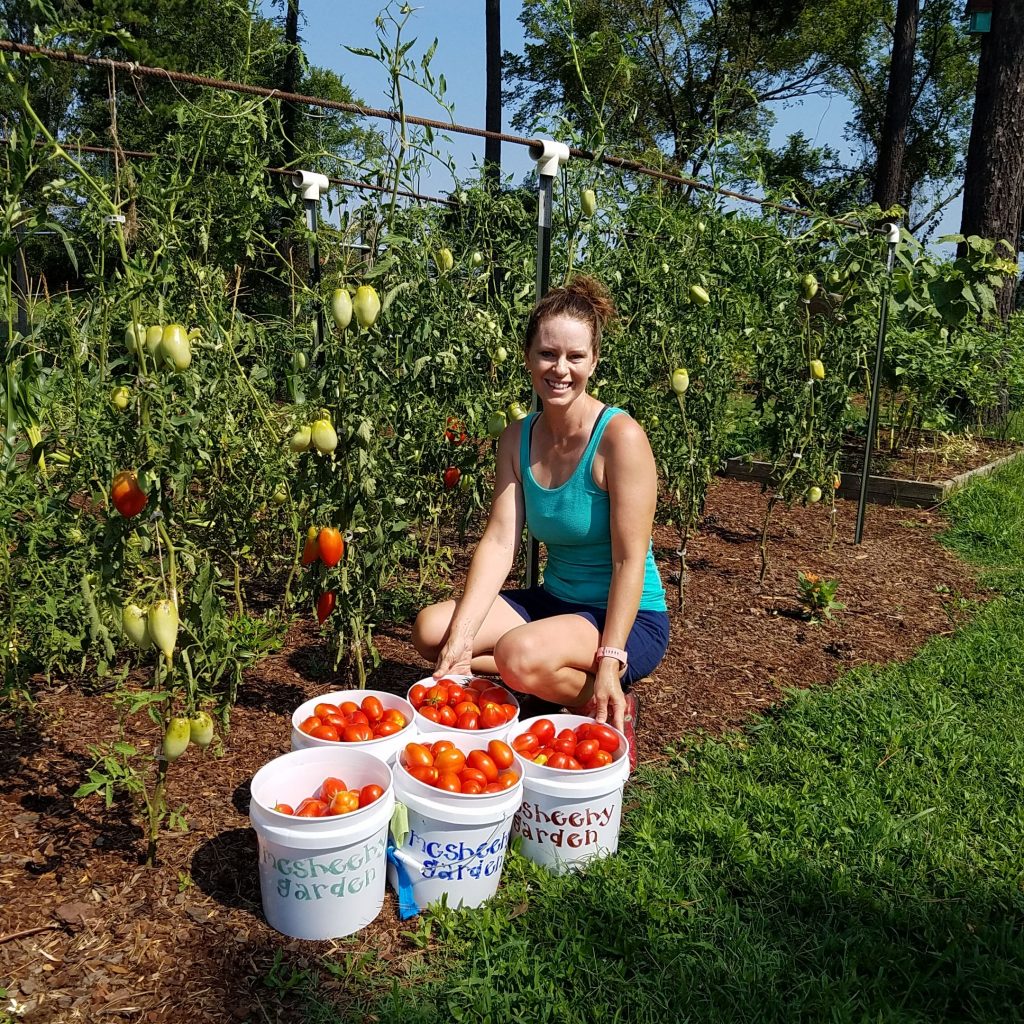
5 Ways to Stop Early Blight on Tomato Plants
Clip yellow leaves and stems ASAP.
Clip stems as soon as you begin to notice the yellowing of the lower leaves with brown spots. If you let them stay on the plant, the fungus will travel from one leaf to another up the plant. By catching it early, you’ll avoid removing too many leaves and stems.
However, in particularly harsh seasons with early blight, you may find many of your stems and leaves gone if you clip them all. That’s okay. First, understand that affected leaves do not help the plant, and the fungus will travel to healthy leaves. Second, as long as you see new, healthy growth on the tomato plant, it should recover.

IMPORTANT: Do not clip the yellow tomato leaves or stems when the plant is wet. Whether because of dew or a recent rain, handling the plant when wet will only spread the fungal spores more. Instead, plan your pruning for the evening, and destroy the affected leaves. Do not compost them.
Remove Lower Tomato Leaves
Clip the lower leaves on your tomato plant, even if they’re unaffected. When the plant reaches about 18″ high, clip all stems growing on the lower 6″ of the plant. As the plant grows higher, aim for no stems on the bottom 12″ of the plant. If the leaves are allowed to touch the soil, early blight will continue to spread.
Mulch to Prevent Early Blight
Mulch thickly. Since early blight originates in the soil, inhibit its path to the plant by laying on a 4″ layer of mulch around the tomato plant.
Personally, I’ve had the best success in preventing early blight when I’ve used hay as a mulch under my tomatoes. But since a recent application of hay mulch poisoned my tomatoes, I’ve gone back to mulching with wood chips. Here are four options for mulch I’ve used in my garden, including the benefits and drawbacks of each.
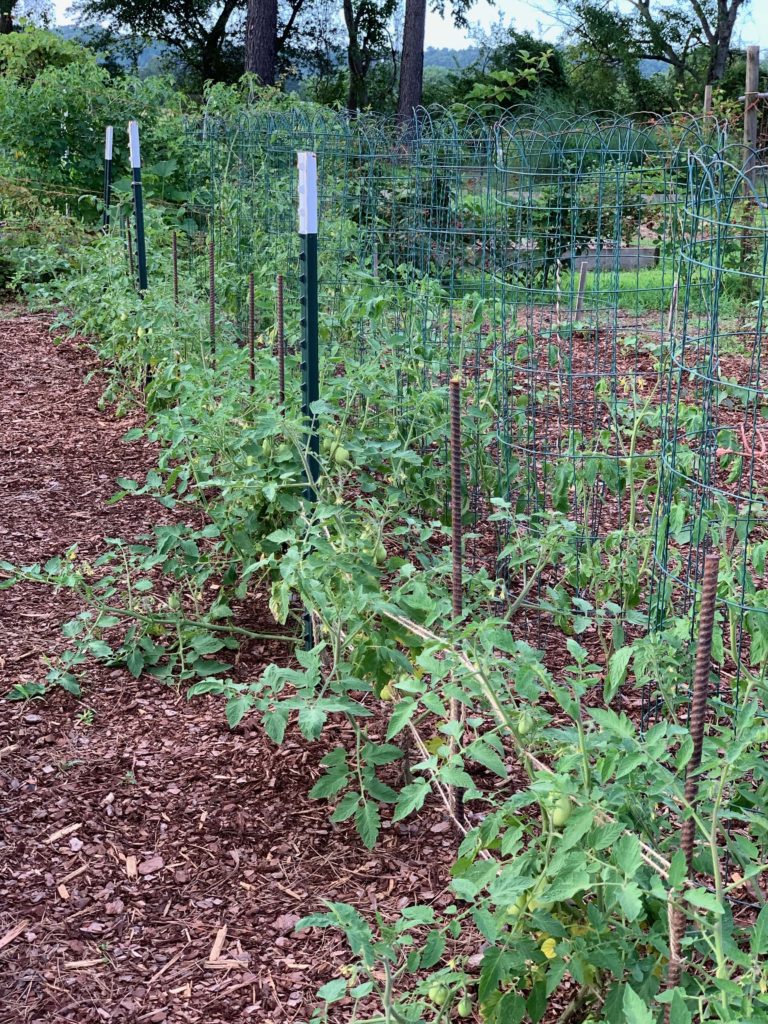
Stay Vigilant, Watching for More Yellowing of Leaves
Continue checking for yellowing over the next few weeks, especially after a rain. I’ve never had early blight go away even after the most prodigious of pruning the yellow leaves. What likely happens is the fungal spores already have traveled to healthy leaves and it takes a few days or more for the leaves to show symptoms.
In particularly rough years, I cut yellow leaves and stems off just about daily.

Tie Up Long Stems
Toward the end of the season, the stems of many indeterminate tomato plants will grow so tall that they could fall over on the ground. Tie up any stems that touch the ground, even if they are healthy. They run the risk of being affected eventually. A good tomato trellis should eliminate this step.
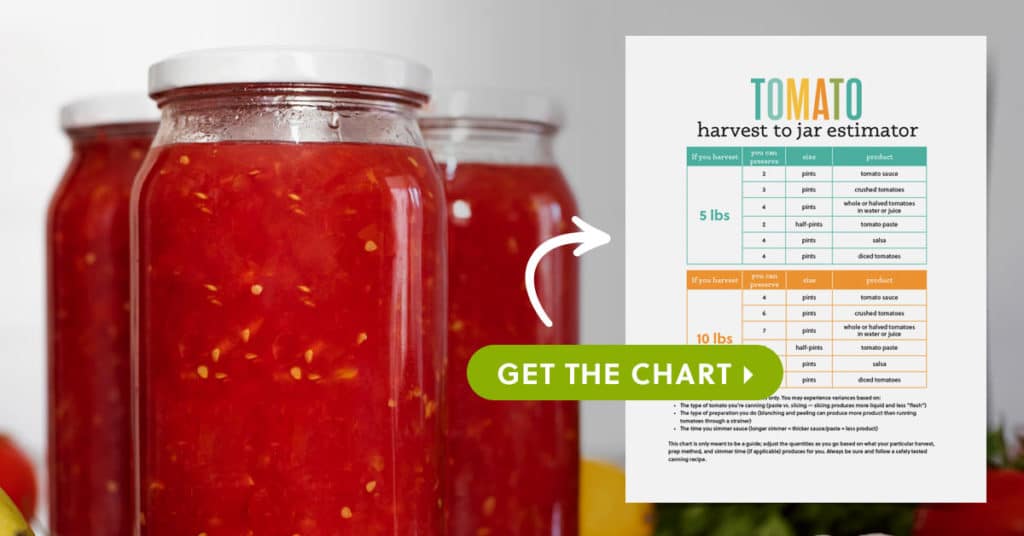
Can early blight be reversed?
No, the yellow leaves will not return to green. Once a leaf is affected, there really isn’t hope for that leaf and even that stem. Cut it off as quickly as possible to stop the spread of the disease. Most likely, your upper leaves — which receive the light anyway — are still healthy if you caught it early enough.
What if I’m Not Sure Why My Tomato Leaves are Yellow?
Yellow tomato leaves are most commonly caused by early blight, but that’s not the only cause. If you’re not sure, you’ll want to read 5 Causes of Yellow Tomato Leaves, where I discuss transplant shock, early blight, Septoria leaf spot, verticillium wilt, and fusarium wilt.

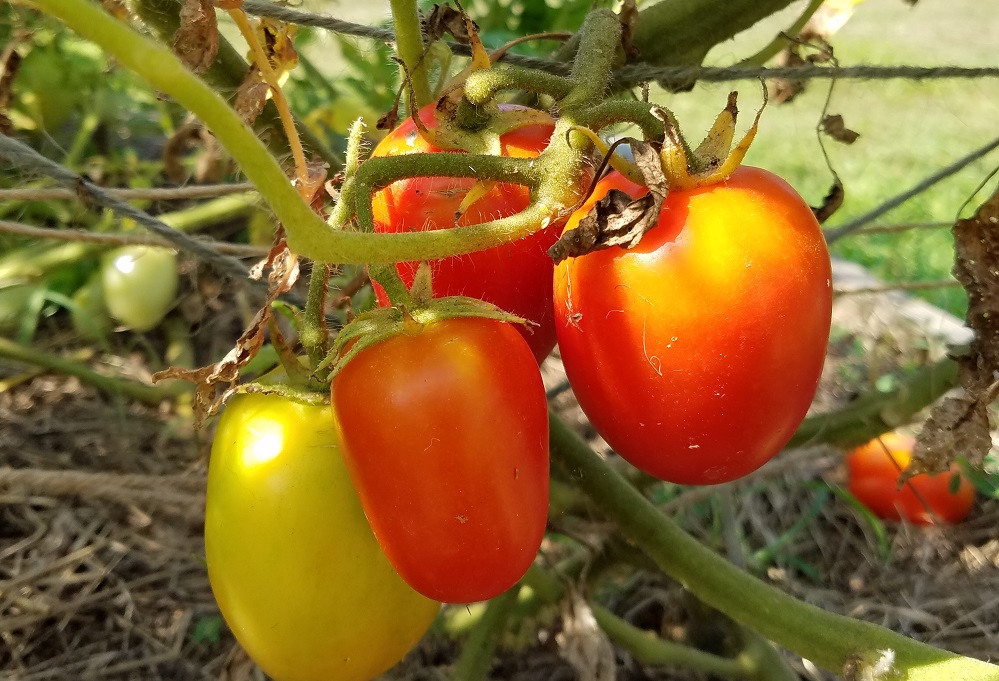
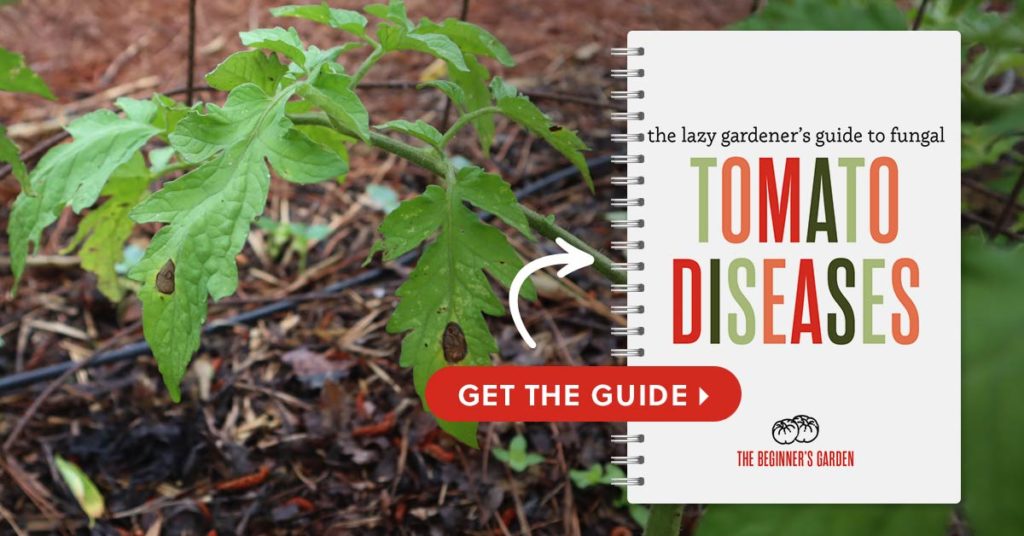
Thanks for all the tips. This is the first year that we have actually been able to grow stuff in our yard. We are going to check for this because it has been really wet and humid. I actually made a video this week with our little garden it you want to stop and look at it. I also have a blog party if you would like to join us. Here is a link to this week’s post. https://youresewtrendy.blogspot.com/2016/06/Our-Garden-Sitting-Among-Friends30.html
Mine do this every year! I always figure I should try a fungicide, but that makes me fear I’ll damage the rest of the plant in this heat. I just do what you suggest – clip off the stems and keep on trucking. I don’t have any red tomatoes yet, but lots of green so far – and maybe a few fruit worms too… 🙁 Can’t win ’em all!
I’m right there with you. I’d rather not start applying fungicide if I can help it! I bet those green tomatoes will turn red soon! Mine just started this week. I haven’t seen any worms yet, fingers crossed!
Worms galore, but no yellow leaves–could be because we live atop at gravel pile with a tad of topsoil over it. 😉
Thanks for the tips, though. When it’s wetter, we do get those yellow leaves. 🙁
How many tomato plants do you usually grow? Just curious.
I have 6 Amish Paste plants in a raised bed, and in my regular garden I have about 6 Roma plants and 10 Hungarian Heart plants. The ones in the raised beds always produce more than in the garden, as I’m working on getting my garden soil in good shape, which can take years. The ones in the raised beds produce half if not more of my total harvest each year, no matter which variety I plant in them.
I haven’t had any trouble with worms so far with tomatoes. I’ve only seen one tomato hornworm in my 4 years of gardening, thankfully!
On my tomatoes and it always looks like it needs water the leaves are drooping I had one tomato and it was small what do I do?
It’s hard to know what the problem might be. If you are growing in a container, it’s possible the container isn’t large enough and the plant has become root-bound, not able to retain and intake water fast enough. If you’re not growing in a container, tomato leaves can droop with too much water just as they can with not enough water. Ensure the plant is getting 1 inch of water per week but not much more than that. Again, I’m just making guesses based on what you’ve shared. I hope this helps!
Thank you so much for the early blight Tip. I’ve been wondering what’s wrong with our tomato plants, and stumbled upon your post randomly today. I will definitely clip those leaves! Thanks again!
I’m glad this was helpful! You might also want to read this post, which gives details on other possible causes of yellow leaves. Early blight is the most common, but this season I realized I had Septoria Leaf Spot as well. https://journeywithjill.net/gardening/2018/05/22/5-causes-of-yellow-tomato-leaves/
here in Ireland we have a long history of blight (irish famine caused by blight on potatoes) we use a lime wash that has been mixed in a copper container. This gives a blue cast on the leaves but will stop blight in its tracks.
Interesting! Does this lime wash come prepackaged or do you create it yourself?
I have a number of tomato plants that might have stayed in their pots a tad too long (over a month) while I was building my raised bed boxes. I transplanted them and they look ok but they don’t seem to be growing. If they are “stunted” is there anything I can do to get them to start growing again? Thanks. Enjoy your website.
Plants will take their time to get acclimated to new conditions. If your nighttime temperatures are lower than 60*F, this will also delay growth. If they look healthy, I recommend giving them time. After a couple of weeks, you could give them a watering with fish emulsion, which should help stimulate growth as well.
I am a nature lover and protector and just want to let your readers know that those ugly tomato hornworms eventually turn into large sphinx moths that look like small hummingbirds. I always plant an extra tomato plant so when I see one of the worms, I move it over to that plant and let it eat and continue its life cycle rather than killing it.
I am not a new gardener but I still like to read the post because a lot of times I learn new ways of doing something & I may be able to offer tips of how I do things especially since I am handicapped & have had to look for ways of doing things easier for me.
Yes I have grown a garden almost all my life , have had no problems with any thing but worms in my tomato plant. I have my tomato plant for about 5 years and they have produce tomatoes all that time too , I love growing a garden and eating the product that I grew , I life in California the San Diego county area , All what I grow is in pots too, Every body says that I have a green thumb , I am retired now and I enjoy life, I do not have much room outside my mobile home.
I look forward to learning new ways and tips for growing in my new garden.
What kind of mulch should I use for my tomatoes?
Thanks!
I use wood chip mulch, but straw is also an excellent mulch for tomatoes and in my experience has more disease suppression capability. Here’s an article that can lend ideas: https://journeywithjill.net/gardening/2016/05/16/4-types-mulch-can-use-garden/
Hi,
Thank you for the great information. I wish I had found it sooner. I had early blight on one of my plants and completely removed it from the container because it had no leaves left. I am wondering is it okay to plant something else in the soil or if I should remove it and completely start over?
Going with the assumption that the tomato plant did indeed have early blight, and not another disease, you can plant something else in a different family. In other words, don’t plant eggplant, peppers, or potatoes in the same pot, but other plants should be fine.
Thanks for this insightful information as I now have an idea why this is occurring. Just have to wait for the rain to stop falling and the sun to come out and cut them off in the evening as suggested. I am in zone 6a and this year we have been recieving more rainy days, which is resulting in what you described. My pruners will be getting a work out when the sun comes out….lol. TY once again.
Sadly, it’s a weekly ritual for me as well!
I have been using grass clippings for mulch. Is that considered a good mulch?
Yes, as long as the lawn hasn’t been treated with any kind of herbicide/pesticide, and as long as you let them dry thoroughly before applying.
I planted Cherry Tomatoes and visioning these beautiful hanging tomatoes overflowing in their pot. First, they got about 16in high and did nothing. Then one day while sitting outside I looked up at them and thought, OH NO the top leaves and more were gone on about 6 plants. I started looking and found 2 of those small green caterpillars. This all happened overnight. I took them off and pulled out the other 6. But they still aren’t doing anything.
Someone told me to mix 1 tablespoon of Epsom Salts in a gallon of water? Another told me they need calcium, to put Tums in the pot? I don’t know if this works or not because I didn’t know how to use the Tums?
Any help would be appreciated!
Nan Potetz
I would not recommend epsom salt or tums for stimulating growth. Nitrogen is a better option for stimulating green growth, which is what you’re wanting to do. I use fish emulsion. Keep in mind, depending on your weather, heat can set back tomato plants, so you may just have to ride it out and keep the plant irrigated until the heat moderates a bit.
Thank you for that advice it makes me feel good because that’s what I am currently doing. You know, I also have that same problem with my lemon cucumber plants. It is really bad with the mature leaves and young leaves turning yellow with big brown spots that looks like the are drying up from the sun or something else. It’s really upsetting to me. I just started gardening last year and the same thing happed. The zucchini quash looks like it has some kind of fungus. I wonder if I am watering too much. Please advise. Thank You.
Yellowing leaves on zucchini and cucumber plants usually indicates something different. It may be a different fungus, or a nitrogen issue, or a heat or water issue. It’s hard to say for sure, but I know I deal with that every year. I usually cut off the affected leaves because the upper leaves are more important for the plant anyway. In my climate, those plants rarely last all summer anyway.
I had my plants in containers, only one or two fruits but plenty of horn worms ate my plants. and not supposed to but were very close to my baby lemon and cherry trees and ate them also.
Just wondering if u received any further information from the post that came from Ireland concerning lime wash mixed in a copper container. I do everything u do plus chemicals and the blight eventually gets my plants. I can delay the disease long enough to get a fairly good crop but hate using the fungicides. Thanks, Mike
No, I haven’t done any of that. I don’t use any chemicals (even organic ones) for this. If you look back in the post, I have a free guide called the “Lazy Gardener’s Guide to Fungal Tomato Diseases” that explains the approach I take. It’s not perfect, but it’s also less work than having to worry about spraying.